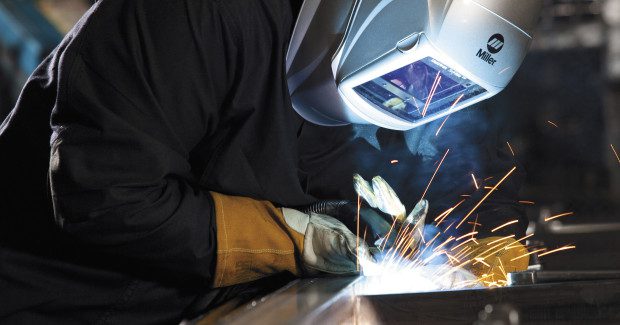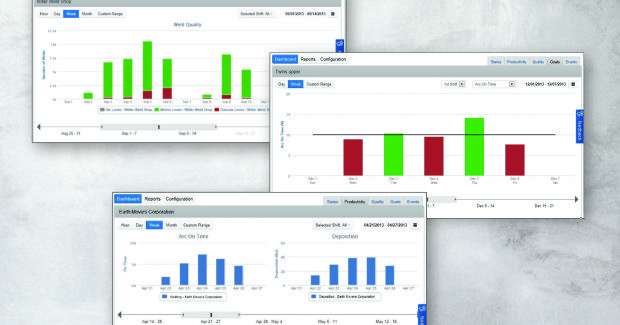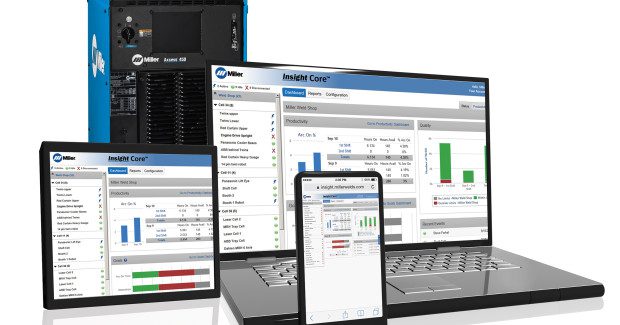Capturing Real Welding Information to Drive Real Improvement
As automation sweeps through the welding industry, the need for weld data beyond just productivity and quality metrics increases. Basic welding information systems provide the operator with real-time information to drive continuous improvement during the actual fabrication of a component. As with any investment in the welding operation, consulting a trusted power source manufacturer or welding distributor is a good first step in determining the most appropriate technology to meet a company’s needs.
Posted: January 23, 2014
As shops seek to increase efficiencies in their welding operations it is vital for them to find resources that can help drive continuous improvement. Greater competition and an oftentimes less experienced workforce require fabricators to implement additional training, as well as activities to increase productivity and lower costs in order to stay on the leading edge of their business. Company initiatives that are capable of reducing quality risks are also critical.
Welding information management systems have become an increasingly appealing means to achieve those goals — for both robotic and semi-automatic welding systems. Basic or entry-level software systems gauge both productivity and quality and provide real-time weld data for management to enact positive changes within the welding operation. Simply put, shops can better identify and solve welding-related problems that may be hindering growth.
Basic welding information management systems offer several key benefits, including:
- The ability to separate fact from fiction — management can garner real data, not just opinions about the welding operation.
- Accurate, real-time data collection (via wired or wireless Ethernet connection), as opposed to time-consuming manual collection.
- Data automatically extracted to the cloud, with easy access via Web browsers.
- Productivity metrics like arc-on time and total deposition.
- The opportunity to identify potential operator-training needs.
- The identification of potential problems (e.g., out-of-threshold welds).
- A benchmark for measuring the impact of continuous improvement initiatives.
ACCESSING THE ADVANTAGES
Besides identifying problem areas in the welding operation, basic welding information management systems provide the data necessary to establish a baseline for improvements based on productivity and quality metrics.
Overview of the Insight Core™ weld data monitoring system from Miller that provides fabricators with the knowledge they need to drive continuous improvement in their welding operations. By gathering real-time information on arc-on times, deposition rates and more, shops can gain better weld quality, increase productivity and improve profitability.
Manufacturers can leverage their current investment in welding equipment by installing welding information management systems via an external module that connects to a welding system in a variety of ways, including external sensing devices; in-line devices between the power source and feeder; and upgrade modules for specific brands of equipment. Some welding systems are also available in factory-built models for those shops that wish to purchase and implement new machines. While all these systems can transmit data via wired Ethernet connection, newer versions of basic welding information management systems come with built-in Wi-Fi capability that allows quick, easy setup and flexibility on the shop floor.
Fabricators can organize their welding information-capable systems in an online asset tree by individual weld cell, department or building (see Utilizing the Dashboards section that follows for a more in-depth explanation). This organization allows management to track and assess how individual machines are performing compared to various departments or the company as a whole. Management or other authorized personnel can access the weld data via a standard Web browser using a secure user ID and password on any Web-enabled device, including a computer, smartphone or tablet. The system generates reports comparing any combination of machines and cells, and there is no software or applications to install or maintain.
The data is available for a given period of time (90 days, for example) so that shops gain an ongoing view of the activities in the welding operation. They can download information into a standard spreadsheet for analysis at a later date in order to assess progress on a longer-term basis. This automatic, real-time data collection offers significant benefits over manual collection. Namely, it is quicker and more accurate. The information also matches the speed of production so management can rectify problems faster, preventing errors from becoming a part of the day’s or week’s production. There is also less opportunity for incorrect interpretation — the data doesn’t rely on opinion, just facts.
UTILIZING THE DASHBOARDS
Some of the better basic welding information management systems feature multiple levels of customizable dashboards that provide management with an “at a glance” view of the last day’s performance. The system provides vital facts about the machines in operation, including:
- Amperage and volts
- Arc-on time and arc starts
- Weld deposition amounts
The comprehensive dashboard system includes a main dashboard that allows management to see a composite overview of the welding operation. Details here include an asset tree, organized according to the company’s preference; machine status indicators (active or idle); arc-on comparisons; performance relative to goals; quality limits; and more. Some systems may also provide a productivity dashboard that can be customized to graphically display arc-on times and deposition, providing a better understanding of how much welding has occurred by the hour, day, week or month. Tracking this information allows shops to identify high and low productivity periods, seek answers to the causes, and identify the need for additional intervention.
Similarly, a quality dashboard shows whether welds are within acceptable limits (i.e., according to a set voltage or amperage threshold defined by management) and capable of meeting quality standards, or if quality risks have increased or decreased over a period of time. With proper drill-down capability, the system could even help identify welding operators who may need additional training. Should any significant event capable of affecting productivity or quality occur, management can be alerted immediately in order to address the problem.
The most capable welding information management systems also allow managers to establish goals for metrics such as arc-on time, deposition, and arc starts, which makes it easy to identify areas in the welding operation that need attention. This dashboard helps management monitor the company’s progress toward its continuous improvement efforts by:
- Evaluating the effectiveness of welding operator training.
- Monitoring the impact of changes to increase arc-on time and welding deposition.
- Assessing the result of steps toward improving weld quality.
In addition to helping identify and track production and quality goals as part of continuous improvement initiatives, the dashboards can collectively help fabricators assess their costs. They provide information to determine true welding costs; identify areas where costs could be reduced; and track the outcome of cost-reduction efforts.
FLEXIBLE CUSTOM REPORTING
Because no company’s welding operation or continuous improvement goals are the same, basic welding information management systems offer powerful reporting tools for customized views of each of these dashboards. These reports make it easier for management to analyze the company’s productivity, quality and goal metrics in a way that is most intuitive to them.
The more sophisticated systems have pre-configured reporting capabilities that make it very easy to evaluate different aspects of the welding operation. These reports typically include arc-on time percentage, comparisons of weld duration (tack welds versus longer welds), trends for arc-on time and arc starts, histograms for arc duration, current and voltage, and a comprehensive detailed weld history. With the flexibility to use the asset tree to show custom machine groupings and the ability to vary the time scope of the reports, presentation of productivity and quality data is almost limitless.
Beyond supporting management initiatives, these reports also help welding engineers identify out-of-threshold welds, assess and improve weld process setup, and monitor machine configurations and performance. Similarly, welding operators become empowered to take an active role in the advancement of their skill sets through the feedback they receive from management.
MAKING THE DECISION
As with any investment in the welding operation, the decision to implement a welding information management system should be made with care and consideration. The goal of this technology is to help manufacturers make continuous improvement decisions based on facts. Still, it is essential for everyone to work together to enact positive changes based on the data collected. It’s a group initiative. Basic welding information systems should be viewed as another tool in the toolbox of continuous improvement — something from which everyone can benefit.
With the cooperation of management, owners, welding engineers and welding operators, the real-time data collected via a welding information management system can help shops enact real change in a manner much more practical than manual collection and interpretation. It can also offer a significant return on the investment in the software (via a retrofitted module) or in a factory-installed fleet. From improving productivity through a better understanding of arc-on time to the identification of quality risks, these systems make it possible to drive continuous improvement initiatives — and monitor their effectiveness. Goals become reality, not just theory, to benefit companies’ bottom lines and competitive position.
For manufacturers that find that they require weld data beyond basic productivity and quality metrics, there are also more advanced welding information systems that build on the premise of providing the operator with real-time information to drive continuous improvement during the actual fabrication of a component. As with any investment in the welding operation, consulting a trusted power source manufacturer or welding distributor is a good first step in determining the most appropriate technology to meet a company’s needs.








